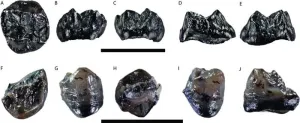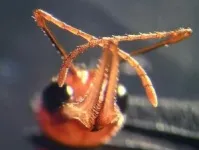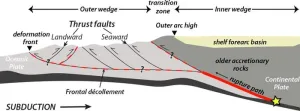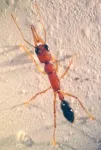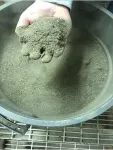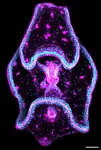(Press-News.org) Ancient apes in Germany co-existed by partitioning resources in their environment, according to a study published June 7, 2024 in the open-access journal PLOS ONE by Madelaine Böhme of Eberhard Karls University of Tübingen, Germany and David R. Begun, of University of Toronto, Canada and colleagues.
The Hammerschmiede fossil site in Bavaria, Germany is best known for exceptional remains of the ancient great ape Danuvius dating to the late Miocene Epoch, 11.6 million years ago. Other experts contest the strength of the evidence to support whether Danuvius is a hominid or whether this is a new genus or not. No Miocene sites in Europe are known to have more than one species of fossil ape, and Hammerschmiede has been no exception until now. In this study, Böhme and colleagues identify a second species of great ape from the same stratigraphic layer as Danuvius.
This new ape is represented by partial remains of two teeth and one patella whose size and shape are distinct from Danuvius and all other known apes. The authors name this new species Buronius manfredschmidi. Based on the structure of the teeth and patella, the authors infer that Buronius was an adept climber which ate a diet of soft foods such as leaves. From the size of the fossils, the authors estimate a full body size of around 10kg, making Buronius the smallest known great ape.
These features suggest that Buronius had a distinct lifestyle from Danuvius, which is a larger bodied species with a diet of tougher foods. These differences likely allowed these two species to share a habitat without competing for resources, similar to modern gibbons and orangutans which share habitats in Borneo and Sumatra. This is the first known example of a European Miocene fossil site with multiple ancient ape species, though the authors suggest that re-examination of other similar sites might uncover more examples of this cohabiting behavior.
The authors add: “The new great ape from Hammerschmiede, Buronius manfredschmidi, is with about 10 kg body weight not only the smallest known crown ape, he attested the first case of hominid syntopy for Europe. The leaf-eating Buronius shared the habitat with the omnivorous bipedal ape Danuvius guggenmosi.”
#####
In your coverage please use this URL to provide access to the freely available article in PLOS ONE: https://journals.plos.org/plosone/article?id=10.1371/journal.pone.0301002
Citation: Böhme M, Begun DR, Holmes AC, Lechner T, Ferreira G (2024) Buronius manfredschmidi—A new small hominid from the early late Miocene of Hammerschmiede (Bavaria, Germany). PLoS ONE 19(6): e0301002. https://doi.org/10.1371/journal.pone.0301002
Author Countries: Germany, Canada
Funding: Since 2020, the excavations and associated research were supported by the Bavarian State Ministry of Research and the Arts and by the Bavarian Natural History Collections (SNSB). DRB acknowledges support from the Natural Sciences and Engineering Research Council of Canada (Grant File Number RGPIN-2016-06761).
END
Tiny new species of great ape lived in Germany 11 million years ago
First ever report of two ancient ape species cohabiting in Miocene Europe
2024-06-07
ELSE PRESS RELEASES FROM THIS DATE:
Cascadia Subduction Zone, one of Earth’s top hazards, comes into sharper focus
2024-06-07
Off the coasts of southern British Columbia, Washington, Oregon and northern California lies a 600 mile-long strip where the Pacific Ocean floor is slowly diving eastward under North America. This area, called the Cascadia Subduction Zone, hosts a megathrust fault, a place where tectonic plates move against each other in a highly dangerous way. The plates can periodically lock up and build stress over wide areas―eventually to be released when they finally lurch against each other. The result: the world’s greatest earthquakes, shaking both seabed and land, and generating tsunamis 100 feet high or more. Such a fault ...
Unlocking another piece of the Parkinson’s puzzle – scientists reveal workings of vital molecular switch
2024-06-07
Scientists at the University of Dundee have uncovered the inner relay of a molecular switch that protects the brain against the development of Parkinson’s disease.
The research provides new potential strategies to develop drugs that may benefit patients with Parkinson’s.
Parkinson’s is the fastest growing brain disorder in the world, however, there are currently no treatments that can slow or arrest the condition.
Previous research conducted at the University had found a gene called PINK1 is central to protecting brain cells against stress. In patients ...
A protein that enables smell—and stops cell death
2024-06-07
While smell plays a considerable role in the social interactions of humans—for instance, signaling fear or generating closeness—for ants, it is vitally important. Researchers from New York University and the University of Florida found that a key protein named Orco, essential for the function of olfactory cells, is also critical for the cells’ survival in ants.
Their study showed that mutating the orco gene in Harpegnathos saltator jumping ants dramatically decreased the number of olfactory neurons, suggesting that Orco is necessary for the development and life of these cells. The findings, published in Science Advances, offer insights into the cellular ...
New research finds lake under Mars ice cap unlikely
2024-06-07
ITHACA, N.Y. – Cornell University researchers have provided a simple and comprehensive – if less dramatic – explanation for bright radar reflections initially interpreted as liquid water beneath the ice cap on Mars’ south pole.
Their simulations show that small variations in layers of water ice – too subtle for ground-penetrating radar instruments to resolve – can cause constructive interference between radar waves. Such interference can produce reflections whose intensity and variability match observations to date – not only in the area proposed to be liquid water, but across the so-called south ...
Study shows link between photo filter use and muscle dysmorphia among teens, young adults
2024-06-07
Toronto, ON, Canada - A new study conducted by researchers at the University of Toronto has unveiled a significant association between the use of photo filters on social media and increased symptoms of muscle dysmorphia among adolescents and young adults in Canada. This study, which analyzed data from 912 participants from the Canadian Study of Adolescent Health Behaviors, emphasizes the growing concern over the impact of digital image manipulation on body image and mental health.
The research reveals that the use of photo filters, commonly found on apps like Snapchat, Instagram, and TikTok, is linked to greater muscle dysmorphia symptomatology, a condition marked ...
Mushroom stump waste could be inexpensive, healthy chicken feed supplement
2024-06-07
UNIVERSITY PARK, Pa. — Feed costs for producing broiler chickens accounts for 60% to 70% of total production costs, and stump waste from the production of button mushrooms comprises nearly 30% of total mushroom weight. Marrying the two has the potential to reduce both cost and waste, especially in Pennsylvania, which is a national leader in the production of broiler chickens and button mushrooms.
To learn whether the two are compatible, a team of Penn State researchers conducted a new study to determine how supplementing the feed of broilers with mushroom stump waste affected the growth and health of the chickens.
In findings ...
Simply looking at the natural world in urban areas can reap benefits
2024-06-07
New eye-tracking research has shown that simply looking at natural elements during urban walks can offer significant mental health benefits.
The study, by Bangor University and Technion- Israel Institute of Technology, published in the scientific journal People and Nature, involved city-dwellers, and showed how paying visual attention to greenery, rather than human-made structures, can alleviate anxiety and enhance restorative feelings.
The 117 urban residents who took part in the study, were guided on a 45-minute urban walk, while wearing eye-tracking ...
Study adds new sea cucumber species to the research toolbox
2024-06-07
By Devon McPhee
WOODS HOLE, Mass. -- Scientists have a handful of standard research organisms, including fruit flies and mice, that they use to study the evolutionary development (evo-devo) of animal lineages over time. Yet the more research organisms they can study, the deeper our understanding of life and the more knowledge we have to advance biomedicine and ecological conservation.
Researchers at the Marine Biological Laboratory (MBL), Woods Hole, and the Stazione Zoologica Anton Dohrn (SZS) in Naples, Italy, have added to the evo-devo toolbox by establishing Holothuria tubulosa, ...
Advancing cancer tracking: DiFC detects rare cells noninvasively
2024-06-07
In the relentless fight against cancer, a new technology promises to shed light on how we track and understand the spread of this disease within the body. A research team from Northeastern University and Dartmouth College recently developed a remarkable tool called "diffuse in vivo flow cytometry" (DiFC), which allows for the noninvasive detection and counting of rare cancer cells circulating in the bloodstream.
Monitoring cancer spread in real time
In a recent publication in the Journal of Biomedical Optics (JBO), the research team detailed their innovative two-color DiFC system, capable of simultaneously detecting two distinct populations of cancer ...
nTIDE May 2024 Jobs Report: People with Disabilities Succeeding in Finding Jobs
2024-06-07
East Hanover, NJ – June 7, 2024 –May job numbers showed gains for people with disabilities, who continue to engage with the labor market at historic levels, according to today’s National Trends in Disability Employment – semi-monthly update (nTIDE), issued by Kessler Foundation and the University of New Hampshire’s Institute on Disability (UNH-IOD). Increases in both labor force participation and employment indicate that people with disabilities are not only striving to work but succeeding in finding jobs. ...
LAST 30 PRESS RELEASES:
UVA’s Jundong Li wins ICDM’S 2025 Tao Li Award for data mining, machine learning
UVA’s low-power, high-performance computer power player Mircea Stan earns National Academy of Inventors fellowship
Not playing by the rules: USU researcher explores filamentous algae dynamics in rivers
Do our body clocks influence our risk of dementia?
Anthropologists offer new evidence of bipedalism in long-debated fossil discovery
Safer receipt paper from wood
Dosage-sensitive genes suggest no whole-genome duplications in ancestral angiosperm
First ancient human herpesvirus genomes document their deep history with humans
Why Some Bacteria Survive Antibiotics and How to Stop Them - New study reveals that bacteria can survive antibiotic treatment through two fundamentally different “shutdown modes”
UCLA study links scar healing to dangerous placenta condition
CHANGE-seq-BE finds off-target changes in the genome from base editors
The Journal of Nuclear Medicine Ahead-of-Print Tip Sheet: January 2, 2026
Delayed or absent first dose of measles, mumps, and rubella vaccination
Trends in US preterm birth rates by household income and race and ethnicity
Study identifies potential biomarker linked to progression and brain inflammation in multiple sclerosis
Many mothers in Norway do not show up for postnatal check-ups
Researchers want to find out why quick clay is so unstable
Superradiant spins show teamwork at the quantum scale
Cleveland Clinic Research links tumor bacteria to immunotherapy resistance in head and neck cancer
First Editorial of 2026: Resisting AI slop
Joint ground- and space-based observations reveal Saturn-mass rogue planet
Inheritable genetic variant offers protection against blood cancer risk and progression
Pigs settled Pacific islands alongside early human voyagers
A Coral reef’s daily pulse reshapes microbes in surrounding waters
EAST Tokamak experiments exceed plasma density limit, offering new approach to fusion ignition
Groundbreaking discovery reveals Africa’s oldest cremation pyre and complex ritual practices
First breathing ‘lung-on-chip’ developed using genetically identical cells
How people moved pigs across the Pacific
Interaction of climate change and human activity and its impact on plant diversity in Qinghai-Tibet plateau
From addressing uncertainty to national strategy: an interpretation of Professor Lim Siong Guan’s views
[Press-News.org] Tiny new species of great ape lived in Germany 11 million years agoFirst ever report of two ancient ape species cohabiting in Miocene Europe
